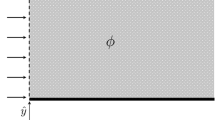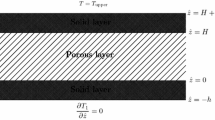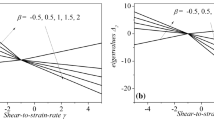Abstract
The problems of how a free convection boundary layer adjusts to a small but sudden change in plate angle, and how it leaves a body with a wedge-shaped trailing edge are discussed. The angle is taken to beO(G r −3/28) so that the flow near the discontinuity can be described by a double deck structure. For plates with very small angle changes, the lower deck equations can be linearised and the resulting equations have been solved using Fourier transforms. In the general case, the lower deck equations have to be solved numerically and results are given for both concave and convex corners and for a range of wedge angles. It is found that for sufficiently large angles there is a region of reversed flow in each case, in the first and last cases in a region centred on the discontinuity, while for convex corners it is downstream of the corner.
Zusammenfassung
Es wird das Problem gelöst wie sich bei freier Konvektion die Grenzschicht an eine kleine aber plötzliche Änderung des Plattenwinkels anpaßt, und wie sie eine keilförmige Hinterkante verläßt. Der Winkel wird von der GrößenordnungO(G r −3/28) gewählt, damit die Strömung nahe zur Diskontinuität durch eine Zweischichtstruktur beschrieben werden kann. Für Platten mit sehr kleinen Winkeländerungen kann man die Gleichungen der unteren Schicht linearisieren und durch eine Fourier-Transformation lösen. Für den allgemeinen Fall müssen die Gleichungen der unteren Schicht numerisch gelöst werden, und wir geben Resultate für konkave und konvexe Ecken sowie für einen Reihe von Keilwinkeln an. Für hinreichend große Winkel konnten wir in allen Fällen eine Umkehr-Strömung feststellen, im ersten und letzten Fall in einem Gebiet mit der Diskontinuität als Zentrum, und für konvexe Ecken stromabwärts von der Ecke.
Similar content being viewed by others
References
A. F. Messiter and A. Liñán, Z. angew. Math. Phys.27, 633 (1976).
F. T. Smith, Q. Jl. Mech. Appl. Math.31, 473 (1978).
K. Stewartson, Adv. Appl. Mech.14, 145 (1974).
D. R. Jones, Q. Jl. Mech. Appl. Math.26, 77 (1973).
K. Stewartson, Q. Jl. Mech. Appl. Math.23, 137 (1970).
K. Stewartson, Proc. Roy. Soc. A319, 289 (1970).
F. T. Smith and P. W. Duck, Q. Jl. Mech. Appl. Math.30, 143 (1977).
S. Ostrach, N.A.C.A. Report 1111 (1953)
L. Rosenhead (ed.),Laminar boundary layers. Clarendon Press, Oxford 1963.
P. G. Daniels, Q. Jl. Mech. Appl. Math.27, 175 (1974).
T. A. Reyhner and I. Flügge-Lotz, Int. J. Non-linear Mech.3, 173 (1968).
D. P. Rizzetta, O. R. Burggraf, and R. Jenson, J. Fluid Mech.89, 535 (1978).
F. T. Smith and J. H. Merkin, submitted to Computers & Fluids.
K. Stewartson, Mathematika16, (1969).
Author information
Authors and Affiliations
Rights and permissions
About this article
Cite this article
Merkin, J.H., Smith, F.T. Free convection boundary layers near corners and sharp trailing edges. Z. angew. Math. Phys. 33, 36–52 (1982). https://doi.org/10.1007/BF00948311
Received:
Revised:
Issue Date:
DOI: https://doi.org/10.1007/BF00948311




